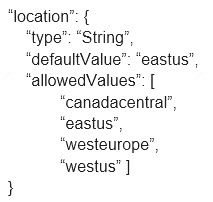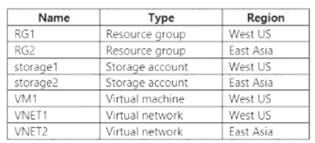Question 19
- (Exam Topic 6)
You have an Azure subscription that contains a user account named User1.
You need to ensure that User1 can assign a policy to the tenant root management group. What should you do?
Correct Answer:B
Question 20
- (Exam Topic 6)
You have an on premises data center and an Azure subscription. The data center contains two VPN devices. The subscription contains an Azure virtual network named VNet1. VNet1 contains a gateway subnet.
You need to create a site-to-site VPN. The solution must ensure that if a single instance of an Azure VPN gateway fails, or a single on-premises VPN device fails, the failure will not cause an interruption that is longer than two minutes.
What is the minimum number of public IP addresses, virtual network gateways, and local network gateways required in Azure? To answer, select the appropriate options in the answer area.
NOTE: Each correct selection is worth one point.
Solution:
Box 1: 4
Two public IP addresses in the on-premises data center, and two public IP addresses in the VNET.
The most reliable option is to combine the active-active gateways on both your network and Azure, as shown in the diagram below.
Box 2: 2
Every Azure VPN gateway consists of two instances in an active-standby configuration. For any planned maintenance or unplanned disruption that happens to the active instance, the standby instance would take over (failover) automatically, and resume the S2S VPN or VNet-to-VNet connections.
Box 3: 2
Dual-redundancy: active-active VPN gateways for both Azure and on-premises networks Reference:
https://docs.microsoft.com/en-us/azure/vpn-gateway/vpn-gateway-highlyavailable
Does this meet the goal?
Correct Answer:A
Question 21
- (Exam Topic 6)
You have an Azure Resource Manager template named Template1 that is used to deploy an Azure virtual machine.
Template1 contains the following text:
The variables section in Template1 contains the following text: "location": "westeurope"
The resources section in Template1 contains the following text:
You need to deploy the virtual machine to the West US location by using Template1. What should you do?
Correct Answer:A
Question 22
- (Exam Topic 4)
You have an Azure subscription.
Users access the resources in the subscription from either home or from customer sites. From home, users must establish a point-to-site VPN to access the Azure resources. The users on the customer sites access the Azure resources by using site-to-site VPNs.
You have a line-of-business app named App1 that runs on several Azure virtual machine. The virtual machines run Windows Server 2016.
You need to ensure that the connections to App1 are spread across all the virtual machines.
What are two possible Azure services that you can use? Each correct answer presents a complete solution. NOTE: Each correct selection is worth one point.
Correct Answer:DE
Line-of-business apps means custom apps. Generally these are used by internal staff members of the company. Azure Application Gateway is a web traffic load balancer that enables you to manage traffic to your web applications.
Internal Load Balancer provides a higher level of availability and scale by spreading incoming requests across virtual machines (VMs) within the virtual network.
Reference:
https://docs.microsoft.com/en-us/azure/load-balancer/load-balancer-overview https://docs.microsoft.com/en-us/azure/application-gateway/overview
Question 23
- (Exam Topic 4)
You create an Azure subscription named Subscription1 and an associated Azure Active Directory (Azure AD) tenant named Tenant1. Tenant1 contains the users in the following table.
You need to add an Azure AD Privileged Identity Management application to Tenant1. Which account can you use?
Correct Answer:B
Admin2 is not Global Administrator, so this option is incorrect. ContosoAdmin1@hotmail.com : Incorrect Choice
Although this user is Global Administrator but referring to the least privileges principal and default domain consideration this option is incorrect.
References:
https://docs.microsoft.com/en-us/azure/active-directory/privileged-identity-management/pim-getting-started https://docs.microsoft.com/en-us/azure/active-directory-domain-services/tutorial-create-instance
Question 24
- (Exam Topic 6)
Note: This question is part of a series of questions that present the same scenario. Each question in the series contains a unique solution that might meet the stated goals. Some question sets might have more than one correct solution, while others might not have a correct solution.
After you answer a question in this section, you will NOT be able to return to it. As a result these questions will not appear in the review screen.
You have an Azure subscription that contains the resources shown in the following table.
VM1 connects to VNET1.
You need to connect VM1 to VNET2.
Solution: You delete VM1. You recreate VM1, and then you create a new network interface for VM1. Does this meet the goal?
Correct Answer:A
Instead you should delete VM1. You recreate VM1, and then you add the network interface for VM1.
Note: When you create an Azure virtual machine (VM), you must create a virtual network (VNet) or use an existing VNet. You can change the subnet a VM is connected to after it's created, but you cannot change the VNet.
References:
https://docs.microsoft.com/en-us/azure/virtual-machines/windows/network-overview